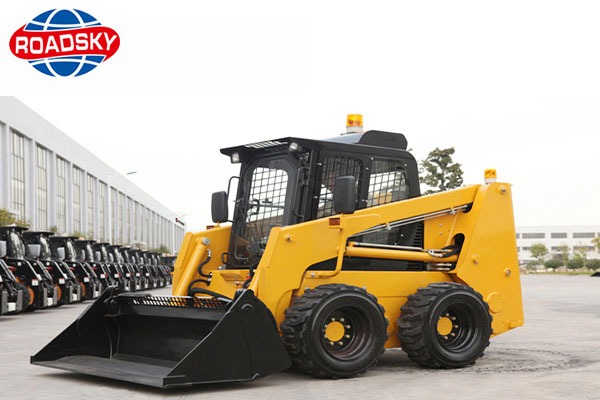How to Load a Skid Steer on a Trailer?
Skid steer loaders are incredibly versatile machines that are commonly used in construction, landscaping, and agriculture. If you need to transport your skid steer from one job site to another, you’ll need to know how to load it safely and efficiently onto a trailer. In this article, we’ll go through the steps involved in loading a skid steer onto a trailer.

Step 1: Choose the Right Trailer
The first step in loading a skid steer onto a trailer is choosing the right trailer for the job. Skid steers can be quite heavy, so you’ll need a trailer that can handle the weight. Make sure the trailer has a weight capacity that exceeds the weight of your skid steer, and that it has the appropriate hitch for your towing vehicle.
Step 2: Position the Trailer
Once you have the right trailer, you’ll need to position it in a flat, level area. Make sure the trailer is positioned in a way that allows you to load the skid steer from a straight angle. This will make it easier to line up the skid steer with the trailer when you’re ready to load it.
Step 3: Prepare the Skid Steer
Before you load the skid steer onto the trailer, you’ll need to prepare it for transport. Start by lowering the skid steer’s bucket and arms to the ground. This will help to lower the center of gravity and make the machine more stable during transport. You should also turn off the engine and engage the parking brake.
Step 4: Align the Skid Steer
Once the skid steer is prepared, you’ll need to align it with the trailer. Position the skid steer directly in front of the trailer, with the bucket facing forward. Make sure the skid steer is centered and aligned with the trailer, and that the tires are lined up with the trailer’s ramps.
Step 5: Lower the Ramps
With the skid steer aligned, you can now lower the trailer’s ramps. Make sure the ramps are fully extended and securely in place before proceeding.
Step 6: Drive the Skid Steer Onto the Trailer
With the ramps in place, you can now drive the skid steer onto the trailer. Slowly drive the skid steer up the ramps, making sure to keep the machine centered and aligned with the trailer. As you drive onto the trailer, keep a steady speed and avoid sudden movements.
Step 7: Secure the Skid Steer
Once the skid steer is on the trailer, you’ll need to secure it for transport. Use chains or straps to secure the skid steer to the trailer, making sure to fasten them to the appropriate points on the machine. Make sure the skid steer is securely fastened before driving away.
FAQ
Skid steers are compact and highly maneuverable machines that use four wheels or tracks to move, while loaders are larger and more powerful machines that use a set of wheels or tracks to move and can handle heavier loads and a wider range of tasks.
Skid steer loaders are versatile machines that are commonly used for a wide range of tasks, including excavation, material handling, landscaping, demolition, snow removal, and construction. They are highly maneuverable and can easily navigate in tight spaces, making them ideal for use in urban and suburban environments. Skid steer loaders can be equipped with a variety of attachments, such as buckets, forks, backhoes, augers, and trenchers, which allow them to perform a variety of tasks, including digging, hauling, grading, and drilling.
Skid steer loaders can be relatively easy to operate, but they do require proper training and experience to operate safely and effectively. The controls of a skid steer can be complex, and operators need to have a good understanding of how the machine functions and how to control it in different situations. Additionally, operators need to be aware of safety guidelines and procedures, such as wearing appropriate personal protective equipment, properly securing loads, and avoiding hazards on the job site. While skid steer loaders can be easy to operate once an operator has received the necessary training and experience, it is important to approach the machine with caution and respect, and to always prioritize safety while using it.
Skid steer loaders can have either tracks or wheels, depending on the specific model and the intended application. Some skid steers have four wheels, with two fixed axles, while others have tracks, similar to those found on bulldozers or excavators. Wheeled skid steers are generally more maneuverable and easier to transport, while tracked skid steers can provide better traction and stability in challenging terrain or harsh weather conditions.
Bobcat is a brand name of skid steer loaders and other construction equipment. While all Bobcats are skid steer loaders, not all skid steer loaders are Bobcats. Skid steer loaders are a type of construction equipment that are used for material handling, excavation, and other tasks, and there are many brands and models available on the market. However, Bobcat has become a well-known and popular brand of skid steer loader due to its high-quality products and innovative design features.
Conclusion
Loading a skid steer onto a trailer can be a challenging task, but by following these steps, you can do it safely and efficiently. Remember to choose the right trailer, position it correctly, and prepare the skid steer before loading it onto the trailer. With a little practice, you’ll be able to load and transport your skid steer with ease.

